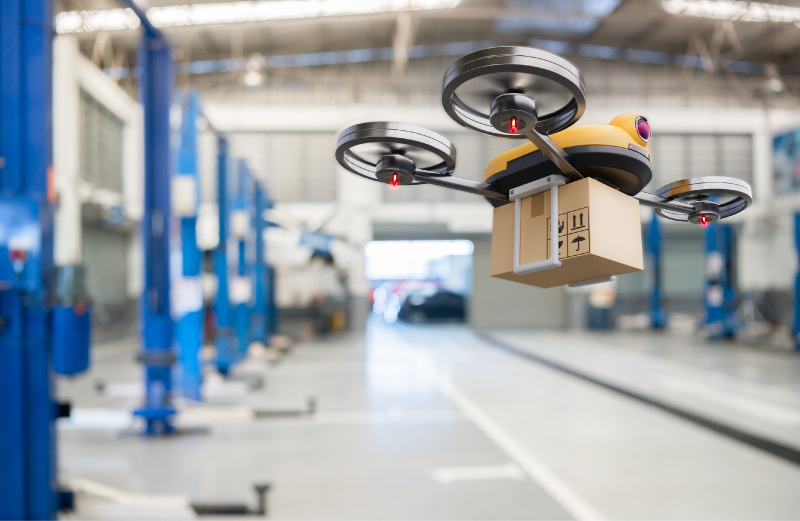Unlocking The Skies: Leveraging Drone Technologies To Improve The Delivery Of Goods And Services In Africa

This is the 30th post in a blog series to be published in 2021 by the Secretariat on behalf of the AU High-Level Panel on Emerging Technologies (APET) and the Calestous Juma Executive Dialogues (CJED)
Africa is the world’s second-biggest and most populated continent, as well as the continent with the most youthful population. In addition, Africa is anticipated to have the fastest urbanisation rate, which can potentially develop the continent into a formidable manufacturing and agricultural hub. These prospects can significantly foster Africa’s socio-economic development in alignment with the aspirations of the African Union’s Agenda 2063: “The Africa We Want”.[1] However, with such a positive outlook, African countries should adequately address critical developmental and infrastructural challenges that currently deter the continent’s socio-economic growth.
Notably, the World Bank has reported that approximately 60% of the African continent’s population lacks access to an enabling infrastructure necessary for connecting Africa’s logistical frameworks. Consequently, this prevents several African communities from adequately accessing healthcare, education, and job creation opportunities, inhibiting economic growth.[2] Currently, only 25% of Africans have access to reliable electricity, and one in every three people have access to clean potable water.[3],[4] Furthermore, less than 7% of arable land in Africa is irrigated.[5] Africa also has limited and poorly constructed transportation infrastructure, and inadequate transportation infrastructure has been an issue against its development.
Africa’s core transportation system includes roads, airports, seaports, and railways. Roads dominate the transportation sector in most African countries and cover approximately 80% of passengers and freight traffic. Approximately US$ 200 billion of Africa’s trade is accomplished through the continent’s road network comprising strategic trading corridors linking deep seaports to economic hinterlands.[6] The late Professor Calestous Juma, in his book “The New Harvest”, noted that Africa’s agricultural production is predominately situated near paved roads that can potentially render easy access to markets.[7] Thus, adequate transportation infrastructure is essential for Africa’s socio-economic development to allow people, goods, and services to move from one place to another.
Notably, Africa’s transportation and logistical linkage systems remain expensive, disjointed, and unreliable. Several African countries, more especially landlocked countries, face soaring transportation costs. The World Bank has reported that when accessing foreign markets from Africa, transportation and insurance costs represent 30% of the total value of exports.[8] This unfavourably compares to about 8.6% against all developing countries.[9]
The primary causes for the inadequate transportation infrastructure in Africa include wars and conflicts, poor planning of transportation infrastructure, corruption, negligence, poverty, and limited political will towards constructing well-structured transportation infrastructure. Fundamentally, this is considered one of the prime reasons for the African continent’s relatively slow socio-economic growth. For instance, at local, national, and regional levels, Africa’s insufficient transportation infrastructure negatively impacts the continent’s food supply chain. This deters effective transportation of commercial products, deliveries of essential drugs, and other goods and services into Africa’s remote areas.
Consequently, with such infrastructural challenges, African countries are barely sustaining their socio-economic obligations and demands. Therefore, addressing vital transportation infrastructure should be prioritised within African countries if the continent is to develop into adequate growth levels.[10]
The COVID-19 pandemic has further highlighted Africa’s inadequate transportation system because of the inability of African governments and businesses to competently and dependably deliver goods and services to their citizenry. Supporting Africa’s transportation systems with emerging technology-based solutions that facilitate the delivery of goods and services needs to be urgently considered. Thus, the African Union High Level Panel on Innovation and Emerging Technologies (APET) is urging African countries to consider drone technology towards addressing Africa’s delivery challenges due to insufficient transportation infrastructure. Fundamentally, APET believes that drone technology, also known as Unmannered Aerial Vehicles (UAVs), can help African countries sufficiently address the existing gaps in Africa’s transportation system.
Some African countries, in partnership with their developmental partners, are already implementing drone technology-enabled delivery systems in their countries. For example, in the Ukewere region in Tanzania, characterised by topographical challenges and located partially in the Lake Victoria region, UAVs are being utilised to deliver medicine and blood for emergency surgeries. In addition, this region uses UAVs to transport medical essentials that are useful for treating patients suffering from malaria and anaemia.[11] As such, in Tanzania, one can deliver supplies to previously inaccessible parts of the Ukewere region on a daily and weekly basis. Because of the improved drone-enabled delivery systems of these essential medicines, unnecessary deaths are avoided.
Notably, UAVs are providing cost-effective transportation alternatives against manned aircraft[12] by enabling the delivery of goods and services in conflict communities such as South Sudan, as well as the Sahel and Lake Chad regions.[13] For example, South Sudan is leveraging drone technologies towards transporting essential personal protective equipment (PPE) necessary for fighting the COVID-19 pandemic. Furthermore, drones are being utilised to transport goods and services in landlocked African countries such as Ethiopia to enable the delivery of essential PPEs and medical supplies into remote areas.
APET has encouraged African countries through an APET report, titled “Drones on the Horizon - Transforming Africa Agriculture”, so to upscale drone technologies for socio-economic activities. Thus, the upscaling of drone technology-enabled delivery systems can be enhanced by strengthening drones’ capacity through an enabling and supporting infrastructure. Fundamentally, African countries should develop enabling policy and regulatory frameworks and strengthen research, development, and innovation towards drone technology advancement. Well-structured and comprehensive stakeholder engagements can further accomplish this.[14]
APET believes that for Africa to adopt and adapt drone technology seamlessly, Member States should augment the sustainable business models for drone-enabled socio-economic activities such as healthcare, agricultural, and services provisions. Therefore, African countries should urgently formulate an enabling policy environment and implement an ecosystem necessary for drone technology in Africa and beyond. Furthermore, African countries should sustainably develop drone technology as an emergency infrastructure and implement drone services as routine infrastructure.
In 2020, Zipline, a delivery drone company, managed to distribute approximately 1 million doses of non-COVID vaccines.[15] This significant delivery pace addressed limitations of healthcare access due to the pandemic restrictions. In addition, Ghana distributed COVID-19 vaccines using Zipline in March 2021 to rural and ex-urban healthcare facilities. Notably, within 3 days, Zipline had effectively dispersed approximately 11,000 doses of vaccine. This was accountable for approximately 13% of Ghana’s total vaccines that were processed during that period.[16]
African countries are also encouraged to establish more open data sharing frameworks pertaining to drone technology utilisation. Currently, Africa has limited publicly available information on the economics and outcomes of drone delivery systems. This includes quantitative information about Member States’ drone technology systems based on national governmental data sovereignty concerns and competitive concerns by companies. Consequently, such data sharing can enable African governments’ regulatory frameworks and enable service providers to evaluate their delivery systems. This can also assist African countries in expanding drone technology operational frameworks in Africa.
For example, India has implemented the “Medicine From The Sky” project that has enabled India’s incubating ecosystem for drone technology delivery systems.[17] This framework has aided Indian companies to launch assessments of drone-delivered vaccines and formulated accompanying policy frameworks. Furthermore, Japan is currently investigating new business models as Zipline’s strategic, operational partnership with Toyota Tsusho Corporation.[18] As such, Japan is currently augmenting third-party implementation models. Recently, Israel has successfully investigated unmanned traffic systems to formulate a nationwide drone delivery network that can include medical goods.[19] In addition, the United States of America has commenced drone delivery of medical supplies by using UPS flying drones at the WakeMed campus in Raleigh, North Carolina.[20] In Africa, Rwanda has also started drone delivery transportation systems of medical supplies.[21] However, these drone technology delivery systematic operations require sustainable financial models to enable their effective implementation.
APET notes that the principal impediment towards fully implementing drone technology delivery operational systems remain the inhibitive regulatory frameworks that govern local, national, and regional airspaces. As such, the civil aviation authorities are significantly challenged with carefully navigating the safety concerns of existing flight operations and people on the ground while enabling effective drone technology operations. Therefore, APET suggests that to adopt drone technologies across the continent fully, considerations should be made towards enabling lifesaving delivery operations. This can effectively improve African people’s livelihoods and health, considering the demand for vaccine access, blood products, and other medical supplies. African countries can progressively formulate an enabling environment necessary for expanding drone technology delivery operational systems and performance-based regulatory frameworks.
In conclusion, the COVID-19 pandemic has significantly amplified interest in drone technology-enabled medical supply chains. Thus, APET is encouraging African countries to pursue drone technology-enabled delivery systems, more especially in rural Africa, before the next possible healthcare crisis. Fundamentally, such efforts can effectively enhance Africa’s healthcare infrastructure through enabling better public and private sector business models, regulatory frameworks, and smart supply chain integration. Africa’s efforts towards transportation enhancement can increase Africa’s sustainable socio-economic development and redefine the transportation sector in Africa. Finally, this can effectively improve investments towards drone technology innovation.
Featured Bloggers – APET Secretariat
Justina Dugbazah
Barbara Glover
Bhekani Mbuli
Chifundo Kungade
[1] https://au.int/sites/default/files/documents/36204-doc-agenda2063_popular_version_en.pdf.
[2] https://www.tralac.org/images/docs/12896/connecting-africa-role-of-transport-infrastructure-exim-bank-working-paper-march-2018.pdf.
[3] https://www.oecd.org/water/GIZ_2018_Access_Study_Part%20I_Synthesis_Report.pdf.
[4] https://openknowledge.worldbank.org/bitstream/handle/10986/31333/9781464813610.pdf?deliveryName=DM10178.
[5] https://reliefweb.int/sites/reliefweb.int/files/resources/240F109982EEBCCD4925762C000A31F6-Full_Report.pdf.
[6] https://www.tralac.org/images/docs/12896/connecting-africa-role-of-transport-infrastructure-exim-bank-working-paper-march-2018.pdf.
[7] https://qz.com/africa/945724/african-countries-still-cant-raise-enough-capital-to-fix-their-poor-road-networks/.
[8] https://documents1.worldbank.org/curated/en/246961468003355256/pdf/521020PUB0EPI1101Official0Use0Only1.pdf.
[9] https://sustainabledevelopment.un.org/content/documents/AfricanReviewReport-on-TransportSummary.pdf.
[10] https://www2.deloitte.com/content/dam/Deloitte/global/Documents/Energy-and-Resources/dttl-er-power-addressing-africas-infrastructure-challenges.pdf.
[11] https://www.aa.com.tr/en/africa/medical-drones-help-save-lives-in-tanzania/2213162.
[12] https://www.commercialuavnews.com/infrastructure/drones-vs-manned-aircraft.
[13] https://www.updwg.org/wp-content/uploads/2021/06/Unlocking-the-Lower-Skies-The-Costs-and-Benefits-of-Deploying-Drones-across-Use-Cases-in-East-Africa.pdf.
[14]https://dc.sourceafrica.net/documents/120081-Drones-on-the-Horizon-Transforming-Africas.html.
[15] https://www.cnbc.com/2021/02/04/role-of-medical-drones-in-global-covid-vaccine-campaign-is-growing.html.
[16] https://www.weforum.org/agenda/2021/04/5-lessons-from-africa-on-how-drones-could-transform-medical-supply-chains/.
[17] https://www.indiatoday.in/india/story/medicine-from-the-sky-drone-delivery-of-vaccines-drugs-to-start-soon-in-telangana-1814336-2021-06-13.
[18] https://www.toyota-tsusho.com/english/press/detail/210330_004792.html.
[19] https://www.ghsupplychain.org/sites/default/files/2019-07/GHSC_PSM_UAV%20Analysis_final.pdf.
[20] https://www.nytimes.com/2019/10/02/us/UPS-drone-deliveries.html.
[21] https://knowledge.insead.edu/blog/insead-blog/africas-drone-medical-delivery-service-saves-lives-in-lockdown-14371.


